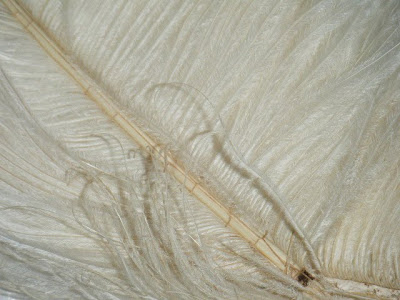Hallo once again my precious darlings, I would like to invite you into a wonderful world, the world of the artists of lightness, the world of feathers. I am once again working in the Brain Watkins House on a short-term contract carrying out an inventory of the collection, and as I do I would like to share with you some of the little delights that I come across. One of the first boxes I opened contained a collection of feathers, and feather hat trims.

Image courtesy of the Tauranga Historical Society
This little number has been separated form its hat, making it difficult to place it in its original era, but if you look closely you can see it is skilfully crafted, and uses a mix of feathers.
Image courtesy of the Tauranga Historical Society
The flat edge at the top of the red feathers suggests they could be turkey feathers, as the fine barbs that can be seen along the top edge of the feathers mean they have not been trimmed to this shape. The Brain sisters raised turkeys, and Bessie Brain worked as a milliner. This makes this little hat trim very interesting, as it could be the work of a local Tauranga milliner, using her own home grown feathers. The black spike looks like a bristle feather, as it does not appear to have any vanes that have been cut off it. Bristle feathers have no vanes at all and are normally found around the eyes and mouth of a bird.

Image courtesy of the Tauranga Historical Society

Turkey Feathers

Image courtesy of the Tauranga Historical Society
There were a number of ostrich feathers in the box, reminding me immediately of the large feathered hats worn during the Belle Epoch, or Edwardian era as it was known in England. If you look closely at the central shaft of the feather, known as the quill, you will see stitches running down it. The stitches are a kind of looping running stitch, almost like a blanket stitch, and must have been used to attach the feather to the hat.
Image courtesy of the Tauranga Historical Society
This group of black feathers is still mounted in a brown felt cover, suggesting it was once a part of a felt hat. I am hoping further research may identify which hat, but possibly the hat is no longer in the collection.

Image courtesy of the Tauranga Historical society
Look at the delicacy of the top two feathers in this group. The lower heavier feather appears to have been trimmed.
Image courtesy of the Tauranga Historical Society
This group of feathers have an iridescent sheen that does not show up well in this image, suggesting they are from a black rooster.
The craft or art of the feather worker or Plumassier, as they are known in France, is almost lost to the world of fashion today. In 1900 over 300 feather workers flourished in Paris, and by 1960 only 50 remained. The 1960's was the death knell for the hat as a required part of a woman's outfit, women abandoned them along with gloves, and the cult of the hairdresser took over that of the miliner.
The Costume and Textile Association of New Zealand is an organisation promoting the interest, study, and conservation of historical and contemporary costume and textiles. The Association has an annual Symposium and at one of these Lynda Cullen gave a presentation on the abandonment of hats and gloves by New Zealand women. She pinpointed the date of this abandonment to 1967, when Jean Shrimpton, a British model, attended the Melbourne cup without wearing a hat or gloves.

Look at the women in the crowd, the older women appear horrified, the younger women look amused. And that mini at least 10cm above the knee, the British hussy.
And so with the demise of the hat, the demand for feathers went with it. In Paris there is practically only one remaining Plumassier, the House of Lemarie. To preserve this unique artform, Chanel purchased Lemarie in 1996, and today Lemarie continues to provide its expert services to French fashion houses such as Dior, Lacroix and Givenchy, as well as Valentino, Dolce and Gabbana and Armani in Italy. Lemarie also produces the famous fabric camellias for Chanel.
Much of the feather maker's art of course depends on a supply of feathers, and Lemarie has a collection of feathers from protected species such as egrets, and birds of paradise, preserved from its founder's days. These cannot be exported from France, and are used as inspiration, or for very specific projects. Feathers that can still be obtained are largely sourced from South Africa today, including vulture, swan, peacock and ostrich feathers.
This overview of feathers, hats and those who fashion them, all inspired by a box of feathers in a Victorian Villa in Tauranga. One of the fascinating aspects of working with this collection, is the love of luxury and all things European it reveals. Although the Brain family lived in the Pacific, on the other side of the world to Europe, their hearts and minds were still linked to European taste and fashion.
If you enjoyed this post and want to have a deeper look, below are some sites that I found interesting, enjoy!
Go to this Etzy site if you want to see turkey feathers available for sale.
This site gives more of an insight into work at the Maison Lemarie
Maison Lemarie
Incredible Feather Art by Kate MccGWire
Soven's Blog, talks about Maison Lemarie
This site has tutorials on making exquisite feather flowers.










